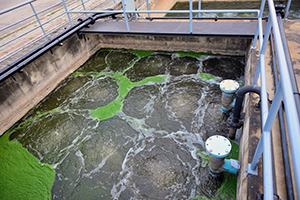
The City Development Initiative for Asia, the Asian Development Bank, other multilateral agencies, and national governments are funding sewerage systems for medium and large cities throughout Asia. Even at “full” sewerage coverage, cities often find that some, if not many, buildings are still reliant on septic tanks, pits, or other onsite systems. For cities with or that are planning sewerage systems, co-treatment may enable citywide sanitation by minimizing the need for standalone fecal sludge treatment plants. Co-treatment processes a city’s sewerage along with the liquids fraction of septage and fecal sludge at common wastewater treatment plants (WWTPs). For new sewerage programs, proper planning can enable co-treatment by appropriately sizing the WWTPs to handle the additional loading from septage. For existing plants, evaluating the capacity of the WWTPs to receive fecal sludge is needed to ensure that effluent quality standards can still be met. WWTPs are not typically designed for the BOD or solids loading that would come with fecal sludge, hence the need for dewatering or liquids/solids separation before the liquid is released into the treatment system.
A recent study initiated by ADBI suggests that co-treatment system projects can exhibit both high net present values and internal rates of return. This offers a stronger potential for private sector involvement in the fecal sludge management (FSM) value chain.
Under co-treatment, the septage liquids can be effectively separated from the solids through mechanized units, such as the skid-mounted press (see Figure 1). The liquids flow to the sewer, while the solids, typically comprising 30%, are stockpiled for use in other commercial ventures (Figure 2).
Figure 1. Trailer-mounted rotary fan press dewatering system

Note: Solids are being dropped into the dumpster in the foreground.
Photo credit: Ashley Muspratt
Figure 2. Sample of solids from press

Note: Can consistently achieve over 30% solids with appropriate dose and type of polymer.
Photo credit: Ashley Muspratt
The small space requirement means that the technology can be designed to fit into dense urban settings. This means that properly equipped decanting stations can be established at strategic locations along sewer line routes to minimize the distance septage delivery trucks have to travel to legally dump their loads. Even if sewer lines are not available, small-space treatment options can reduce trucking distances and thereby have positive spillover effects.
A co-treatment comparison toolkit (currently a beta version), developed through the direction of Seetha Ram of ADBI under a partnership with the Bill & Melinda Gates Foundation, suggests that the financial internal rate of return can be as high as 21% for co-treatment, compared with between 10% and 15% for typical septage treatment facilities. This indicates a potential entry point for private sector investment.
Much of the spillover effects are obtained through the reduction in septage delivery truck travel time, which reduces the number of trucks required, fuel consumption, consumables (i.e., tires), and personnel. The toolkit assesses variables, including the flow of septage per day, the capacity of the trucks, and drive times and distances, to allow for comparison of the spillover effects of sewerage systems with and without co-treatment capabilities.
For city or water-utility managed FSM programs to be sustainable over the long term, they must operate through tariffs that adequately cover the cost of delivering the service. Programs that reduce this cost can allow operators to (i) use the savings to expand the services to the urban poor, (ii) reduce costs to consumers, and (iii) in the case of the private sector, generate profits. Effective programs can be designed to achieve all three.
A public–private partnership between a private sector service provider that furnishes the equipment and runs the facility (operator), and a city or water utility that generates a tariff revenue stream can be effective. The public entity collects the fees and subcontracts to the operator to perform the service. EnviroKonsult (http://www.envirokonsult.com/) in the Philippines is demonstrating the effectiveness of public–private partnerships with large cities for performing FSM-related services. Its Cordova Cebu, Philippines, FSM project is an example of private sector involvement in citywide sanitation. It processes 150 cubic meters of septage per day. The water utility charges about $1 per family per month for desludging services that are scheduled every 3–5 years. While the Cebu project does not involve co-treatment, it does utilize state-of-the-art liquids/solids separation, which enables a very small space septage treatment facility (Figure 3). In this case, they were able to install the system within the community being served, drastically reducing the travel time and maximizing the spillover effect value, making it an attractive investment for the firm.
Figure 3. EnviroKonsult septage treatment plant using screw press and sequencing batch reactor technology

Photo credit: Ashley Muspratt
ADBI is continuing its work to refine their model by applying it to key cities throughout Asia. When finished, it should be a useful tool for motivating public and private operators to act and say yes to citywide FSM and co-treatment where applicable.









Interesting topic